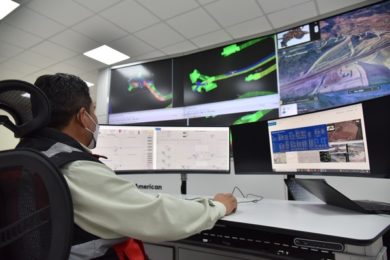Anglo American says it has implemented cutting-edge technology at the Quellaveco copper mine in Peru with which it is possible to create a virtual replica that simulates everything that happens in its process plant, and with this, digital mining specialists can carry out predictive tests that help reduce security risks, optimise the use of resources and improve the performance of production teams.
The digital twins allow virtual replicas of the equipment and infrastructure to be made, displaying information on technical characteristics and operation utilising IoT, with the same data as that provided by the sensors installed in the mine. The digital twins are controlled from the Integrated Operations Center (CIO), which is the brain of Quellaveco. There are twins of the grinding system, flotation, tailings management, water control, electrical system, among others. These are learning and provide recommendations to avoid failures in the equipment or real processes, optimising costs and time, through simulations of the different processes, using artificial intelligence (AI).
“Digital twins not only allow us to have better performance, but they increase safety by reducing error rates, which means a new standard of efficiency in the mining industry,” says Cinthya Lozano, Superintendent of the Integrated Operations Center of Anglo American. “For example, we can place a parameter in a pump and see how it behaves. If it doesn’t work properly, we change these parameters as many times as necessary, and when we have the correct data we just take it to the real world,” she adds.
Quellaveco is one of the first mines to implement digital twin technology to improve efficiency and safety in its mineral processing plant, taking advantage of the connectivity and sensorisation that have made it the first 100% digital mine in Peru.
Underpinning the Anglo American Quellaveco digital twin is the COMOS platform from Siemens which integrates Siemens’ own process control system Simatic PCS-7, which for example controls the gearless driven conveyors and grinding circuit, together with other systems. The integrated COMOS software solution makes it possible to consolidate automation data from the control systems of different providers.
Siemens states: “It guarantees the optimal collaboration, continuity, and consistency of all the disciplines involved in plant engineering and operation. The system accomplishes this by consolidating a variety of sources. Using the automation digital twin of the COMOS software solution, automation data can be read out of the process control system and imported to COMOS to be graphically displayed, consolidated, and made available for further engineering. COMOS uses this data to support the creation of the plant’s digital twin, a fast and reliable migration, and updates to the process control system – all with one single solution.”










